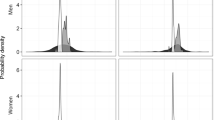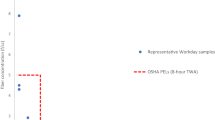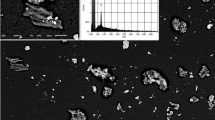Abstract
Increasing evidence indicates that exposure to particulate matter (PM) at environmental concentrations increases the risk of cardiovascular disease, particularly PM with an aerodynamic diameter of less than 2.5 μm (PM2.5). Despite this, the health impacts of higher occupational exposures to PM2.5 have rarely been evaluated. In part, this research gap derives from the absence of information on PM2.5 exposures in the workplace. To address this gap, we have developed a job-exposure matrix (JEM) to estimate exposure to two size fractions of PM in the aluminum industry. Measurements of total PM (TPM) and PM2.5 were used to develop exposure metrics for an epidemiologic study. TPM exposures for distinct exposure groups (DEGs) in the JEM were calculated using 8385 personal TPM samples collected at 11 facilities (1980–2011). For eight of these facilities, simultaneous PM2.5 and TPM personal monitoring was conducted from 2010 to 2011 to determine the percent of TPM that is composed of PM2.5 (%PM2.5) in each DEG. The mean TPM from the JEM was then multiplied by %PM2.5 to calculate PM2.5 exposure concentrations in each DEG. Exposures in the smelters were substantially higher than in fabrication units; mean TPM concentrations in smelters and fabrication facilities were 3.86 and 0.76 mg/m3, and the corresponding mean PM2.5 concentrations were 2.03 and 0.40 mg/m3. Observed occupational exposures in this study generally exceeded environmental PM2.5 concentrations by an order of magnitude.
This is a preview of subscription content, access via your institution
Access options
Subscribe to this journal
Receive 6 print issues and online access
$259.00 per year
only $43.17 per issue
Buy this article
- Purchase on Springer Link
- Instant access to full article PDF
Prices may be subject to local taxes which are calculated during checkout



Similar content being viewed by others
References
Brook RD, Rajagopalan S, Pope CA, Brook JR, Bhatnagar A, Diez-Roux AV et al. Particulate matter air pollution and cardiovascular disease. an update to the scientific statement from the American heart association. Circulation 2010; 121: 2331–2378.
Dockery DW, Pope CA, Xu X, Spengler JD, Ware JH, Fay ME et al. An association between air pollution and mortality in six U.S. cities. N Engl J Med 1993; 329: 1753–1759.
Gan WQ, Koehoorn M, Davies HW, Demers Pa, Tamburic L, Brauer M . Long-term exposure to traffic-related air pollution and the risk of coronary heart disease hospitalization and mortality. Environ Health Perspect 2011; 119: 501–507.
Law MR, Morris JK, Wald NJ . Environmental tobacco smoke exposure and ischaemic heart disease: an evaluation of the evidence. BMJ 1997; 315: 973–980.
Mills NL, Donaldson K, Hadoke PW, Boon Na, MacNee W, Cassee FR et al. Adverse cardiovascular effects of air pollution. Nat Clin Pract. Cardiovasc Med 2009; 6: 36–44.
Peters A, Dockery DW, Muller JE, Mittleman MA . Increased particulate air pollution and the triggering of myocardial infarction. Circulation 2001; 103: 2810–2815.
Peters A, Liu E, Verrier RL, Schwartz J, Gold DR, Mittleman M et al. Air pollution and incidence of cardiac arrhythmia. Epidemiology (Cambridge, Mass.) 2000; 11: 11–17.
Pope CA, Burnett RT, Krewski D, Jerrett M, Shi Y, Calle EE et al. Cardiovascular mortality and exposure to airborne fine particulate matter and cigarette smoke: shape of the exposure-response relationship. Circulation 2009; 120: 941–948.
Smith KR, Peel JL . Mind the gap. Environ Health Perspect 2010; 118: 1643–1645.
The Health Consequences of Smoking: a report of the Surgeon General. [Atlanta, Ga]: Department of Health and Human Services, Centers for Disease Control and Prevention, National Center for Chronic Disease Prevension and Health Promotion, Office on Smoking And Health; Washington, DC: For sale by the Supt. of Docs., US G.P.O., 2004.
U.S. Department of Health and Human Services. The Health Consequences of Smoking: Cardiovascular Disease. A Report of the Surgeon General U.S. Department of Health and Human Services, 1983.
Benke G, Abramson M, Sim M . Exposures in the alumina and primary aluminium industry: an historical review. Ann Occup Hyg 1998; 42: 173–189.
Fritschi L, Sim MR, Forbes A, Abramson MJ, Benke G, Musk AW et al. Respiratory symptoms and lung-function changes with exposure to five substances in aluminium smelters. Int Arch Occup Environ Health 2003; 76: 103–110.
Donoghue AM, Frisch N, Ison M, Walpole G, Capil R, Curl C et al. Occupational asthma in the aluminum smelters of Australia and New Zealand: 1991–2006. Am J Ind Med 2011; 54: 224–231.
Sim M, Benke G . World at work: hazards and controls in aluminium potrooms. Ann Occup Hyg 2003; 60: 989–993.
Akbar-khanzadeh F . Exposure to particulates and fluorides and respiratory health of workers in an aluminum production potroom with limited control measures. Am Ind Hyg Assoc J 2010; 56: 1008–1015.
Weinbruch S, Benker N, Koch W, Ebert M, Drabløs PA, Skaugset NP et al. Hygroscopic properties of the workroom aerosol in aluminium smelter potrooms: a case for transport of HF and SO2 into the lower airways. J Environ Monit 2010; 12: 448–454.
Kongerud J, Boe J, Sùyseth V, Naalsund a, Magnus P . Aluminium potroom asthma: the Norwegian experience. Eur Resp J 1994; 7: 165–172.
Sunderman FW . Review: nasal toxicity, carcinogenicity, and olfactory uptake of metals. Ann Clin Lab Sci 2001; 31: 3–24.
Armstrong BG, Gibbs G . Exposure-response relationship between lung cancer and polycyclic aromatic hydrocarbons (PAHs). Occup Environ Med 2009; 66: 740–746.
Armstrong BG, Tremblay CG, Cyr D, Thériault GP, Thsriault GP . Estimating the relationship between exposure to tar volatiles and the incidence of bladder cancer in aluminum smelter workers. Scand J Work Environ Health 1986; 12: 486–493.
Thomassen Y, Koch W, Dunkhorst W, Ellingsen DG, Skaugset N, Jordbekken L et al. Ultrafine particles at workplaces of a primary aluminium smelterw. J Environ Monit 2006; 8: 127–133.
Höflich BLW, Weinbruch S, Theissmann R, Gorzawski H, Ebert M, Ortner HM et al. Characterization of individual aerosol particles in workroom air of aluminium smelter potrooms. J Environ Monit 2005; 7: 419–424.
Cullen MR, Vegso S, Cantley L, Galusha D, Rabinowitz P, Taiwo O et al. Use of medical insurance claims data for occupational health research. J Occup Environ Med 2006; 48: 1054–1061.
NIOSH Method of Analytical Methods, 4th edition. Methods. Cincinnati, Ohio 1994.
Seixas NS, Robins TG, Moulton LH . The use of geometric and arithmetic mean exposures in occupational epidemiology. Am J Ind Med 1988; 14: 465–477.
Assigned Protection Factors for the Revised Respiratory Protection Standard, OSHA. 3352-02. Occupational Saftey and Health Administration, US Department of Labour; OSHA Publications office, Washington DC, 2009.
Adams WC . Measurement of Breathing Rate and Volume in Routinely Performed Daily Activities. Sacramento, CA. 1993 p 185.
Acknowledgements
We acknowledge the contribution of the following people: the Alcoa industrial hygienists and employees who participated in the sampling campaigns at each facility and Linda Maillet, Judi Caldwell Kuntz, Regi Jennings, Ralph Krobot, Bob Barr, and Jill Abston. This work was supported by National Institutes of Health, Institute of Aging (5R01 AG026291–06 Disease, Disability and Death in an Aging Workforce: The Alcoa Study), Center for Disease Control and Prevention, National Institute of Occupational Safety and Health (5R01OH009939–02: Occupational Exposure to PM2.5 and Cardiovascular Disease), and by Alcoa, Inc.
NIA Data Sharing: As an alternative to providing a de-identified data set to the public domain, we allow access for the purpose of re-analyses or appropriate “follow-on” analyses by any qualified investigator willing to sign a contractual covenant with the host Institution limiting use of data to a specific agreed upon purpose and observing the same restrictions as are limited in our contract with Alcoa, such as 60-day manuscript review for compliance purposes.
Author information
Authors and Affiliations
Corresponding author
Ethics declarations
Competing interests
Dr. Noth, Dr. Liu, and Dr. Eisen declare no potential for conflict of interest. Ms. Dixon-Ernst is a senior industrial hygienist for Alcoa, Inc. Ms. Cantley and Ms. Tessier-Sherman receive salary support from Alcoa, Inc. through contracts with Yale University. Dr. Cullen receives salary support from Alcoa, Inc. through contracts with Stanford University. Dr. Hammond has received compensation as a member of the scientific advisory board for Alcoa, Inc. She has also consulted for Alcoa, Inc. and received compensation.
Additional information
Supplementary Information accompanies the paper on the Journal of Exposure Science and Environmental Epidemiology website
Supplementary information
Rights and permissions
About this article
Cite this article
Noth, E., Dixon-Ernst, C., Liu, S. et al. Development of a job-exposure matrix for exposure to total and fine particulate matter in the aluminum industry. J Expo Sci Environ Epidemiol 24, 89–99 (2014). https://doi.org/10.1038/jes.2013.53
Received:
Revised:
Accepted:
Published:
Issue Date:
DOI: https://doi.org/10.1038/jes.2013.53
Keywords
This article is cited by
-
Economy Versus Environment: How Corporate Actors Harm Both
Critical Criminology (2019)



